Heuchera is a herbaceous perennial from the large Saxifraga family, which received its unusual name in honor of the respected German botanist Heinrich von Heucher. The birthplace of the flowering culture is North America. Numerous species and varieties of this flower are highly respected and popular among landscape designers and professional flower growers.
Compact in shape and size, the bush, about half a meter high, attracts attention with its exquisite foliage and unique palette of colors and shades.
| Content:
|
The peculiarity of the plant is its ability to change the color of the surface of the leaf blades several times throughout the growing season.
Modern heuchera varieties combine many colorful combinations.
Description and characteristics of the plant
Heuchera is a compact flowering bush. The rhizomatous perennial crop consists of long-petioled leaves, paniculate inflorescences and fruits with seeds.
|
Heuchera bushes |
Leaf plates differ in shape, color, texture, and size.They can be smooth, folded, curly, with a variety of patterns on the front side and multi-colored veins, with various inclusions and spots, with a smooth or jagged edge.
|
It is difficult to list the color options for heuchera leaves in full - these are shades of red and purple, green and burgundy, yellow and silver, bright saturated and dark, almost black tones. |
Inflorescences - panicles of small bell-shaped flowers adorn the plants throughout the summer. They are presented in white, pink, cream, red shades.
|
Ripe fruits - boxes contain many small seeds. There are about twenty thousand pieces in one gram. |
Landscape designers and compilers of flower arrangements have been using heuchera in their work for decades.
Tips for growing heuchera
Despite all the unpretentiousness of heuchera and the simple process of growing it, beginner gardeners should know some of the features and requirements of the flowering crop.
|
On bushes of decorative deciduous varieties, it is recommended to regularly remove the flower stalks that rise above the plants, as they look sloppy and spoil the overall picture. They are left only to collect seed material in the fall. |
On bushes of decorative flowering varieties, flower stems are cut off only when flowering has ended.
The decorative appearance of a bush often suffers due to the foliage in the lower part of the bush flying away over time. In order to hide the bald trunk, before flowering the bush is removed from the soil along with a lump of earth and planted to a greater depth.
When growing heuchera from seeds, the varietal characteristics of the parent plant are not preserved.Seedlings of beautiful, varietal heuchera should be purchased in specialized stores, or cuttings from parent bushes should be used.
At the beginning of growth, young leaves look like thin flower petals; they are translucent and painted in bright, rich shades. After some period of time, their surface will become darker and their structure more dense.
Ornamental cereals, primroses and daylilies, astilbe and bergenia will be good companions in the flower bed and flower garden.
How to properly land
Choice of dates and site
For shade-loving crops, it is recommended to choose a site in the direction of the west or east next to taller crops that will create shade during the midday hours. In the morning and evening, direct rays will fall on such an area, the rest of the time there will be bright but diffused light.
|
The optimal time for planting seedlings in open ground is from mid-March to April. |
If an open, sunny area was chosen for planting, then in such conditions the flowers will require regular watering in large volumes.
Reference! Heuchera varieties with brightly colored foliage look much more beautiful and impressive in open sunny areas. Varieties with red foliage change their color to green shades in a shaded area.
What should the soil be like?
Any soil except acidic soil is suitable for growing heuchera. In the natural environment, crops are found even in rocky areas. The most favorable area will be a site with neutral soil, with good water and air throughput, nutritious in composition and loose in structure. In such a flower garden the bush will grow thicker, bloom more profusely and look more impressive.
Important! Heavy, dense soils with stagnant liquid lead to the appearance of root rot and the death of the plant.Sand, compost or peat should be added to such areas when digging.
Sowing seeds
Seeds can be planted immediately in open ground, but the varietal characteristics of the seedlings are not preserved. Most likely, ordinary bushes with green leaves will grow from the seeds. Seed material is planted in moist, loose soil in an open flower bed.
The seedling growing method is more effective. The first shoots, both under cover and in an open garden bed, appear in a month to a month and a half.
|
To grow seedlings you will need mini greenhouses. |
Caring for seedlings consists of providing adequate lighting, regular ventilation, moderate moistening of the substrate and timely picking. Grown seedlings are planted in holes to a depth of about four centimeters, the interval between seedlings is twenty centimeters.
Rules for caring for heuchera
The unpretentiousness of the ornamental plant allows you to devote a minimum of time and effort to it, but even with such care, the heuchera fully develops and never ceases to amaze with its beauty.
When and what to feed
Every year during the growing season, starting from the age of two, plants need additional feeding. It is recommended to apply complex mineral fertilizers before flowering and after its completion. Depending on the variety, mineral complexes are used for deciduous or flowering plants. The solution is prepared strictly according to the instructions, but only half the specified volume is applied to each bush.
Frequency and methods of watering
The optimal irrigation regime is daily morning and evening watering during a hot, dry period with a long absence of rain, or three to four waterings every week at moderate daytime temperatures.
|
Heuchera can withstand insufficient watering and drought much more easily than stagnant moisture in the roots. |
Water must be applied under the root so that drops do not fall on the above-ground part. Due to direct rays of the sun and water droplets, spots - burns - may appear on the leaves.
Mulching
Caring for plants will be incomplete without careful and constant weeding and regular loosening of the soil, but all this can be avoided by mulching. A mulching layer of peat will maintain moderate moisture in the soil even on hot days and prevent the appearance of weeds.
Care after flowering
The flowering period begins in the first half of June and lasts two to two and a half months. As soon as this period ends, it is necessary to prune flower stalks with faded inflorescences.
If you need to collect seeds, then the flower stems remain until the seed material is completely ripe.
Preparing for winter, wintering
The plant overwinters quietly in open ground under certain conditions:
- Do not rush to trim dry and yellowed leaves in the autumn months. In the winter cold it will become a reliable protection of the root system from freezing.
- You will need a shelter made of a thick layer of fallen oak leaves.
- In early spring, when the snow has melted, the leaf cover is removed and last year's leaves are trimmed to a height of about three centimeters from the ground surface.
All that remains is to cover the heuchera bushes with dry leaves
Pests and diseases
One of the positive features of the plant is its high resistance to diseases and pests.But sometimes such problems still arise due to improper care, and specifically due to excessive watering, improper preparation of the soil for planting and stagnation of liquid in the soil, as well as due to excessive application of fertilizing and fertilizers.
- When pests such as leaf nematodes, caterpillars, snails, slugs and weevils appear, it is necessary to treat the bushes with special insecticides.
- If there are signs of powdery mildew, namely a whitish coating on the leaf blades, treatment with any fungicidal preparation will be required.
- Spraying with a solution of Bordeaux mixture (repeatedly, every fifteen days) will cure heuchera from various types of spotting and rust.
How does heuchera reproduce?
Dividing the bush
This method is used for bushes aged three to four years, no younger, for the purpose of propagation and rejuvenation of the crop. Favorable time is the end of May or the beginning of September.
|
The cuttings are planted in planting holes about thirty centimeters deep at intervals of twenty to twenty-five centimeters, watered abundantly and covered with a mulch layer. |
The bush is carefully removed from the ground, divided into parts so that each of them has two to three rosettes. Inspect the root part of each division, remove rotten roots and shorten too long ones, then sprinkle the cut areas with activated carbon powder.
Cuttings
Favorable time for cuttings is June - July. Cuttings cut from an adult bush are divided into small fragments four to six centimeters long, the cut areas are sprinkled with root formers, and some of the leaves are removed. To root cuttings, you will need a substrate made of equal parts of coarse sand and peat and a homemade greenhouse placed in a semi-shaded area.Caring for seedlings involves timely moistening of the soil and regular ventilation. If all growing conditions are met, rooting will occur within twenty to thirty days.
The best varieties of heuchera with photos
All varieties are divided into two large groups - decorative deciduous and decorative flowering. When choosing a variety for your garden or personal plot, you must take into account that heuchera is not afraid of the darkest shady places and gets along well next to hostas, as well as with a variety of tall vegetation. The list below contains a selection of the most attractive and easy-to-care varieties.
Delta Dawn
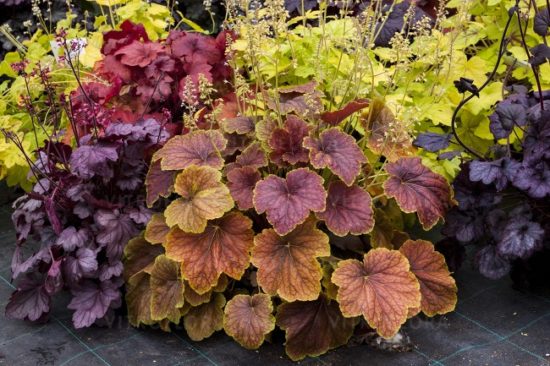
Heuchera Delta Don (Delta Dawn) |
Compact variety, excellent for group plantings. It is distinguished by strong immunity and incredible endurance, which manifests itself in resistance to various viruses and bacteria, harmful insects, drought, prolonged heat and long rainy periods.
|
Delta Don prefers to grow in shade and partial shade. |
In an open area with bright sunlight, the leaf blades lose their individual color and attractiveness. And it consists of a green color with red veins, which over time become red with a golden-yellow edging along the entire edge.
- Bush height – 20-30 cm
- Bush width – 25-30 cm
- Distance between plants – 22-30 cm
- Flowering time: June - July
- Lighting – sun, partial shade, shade
Georgia Peach
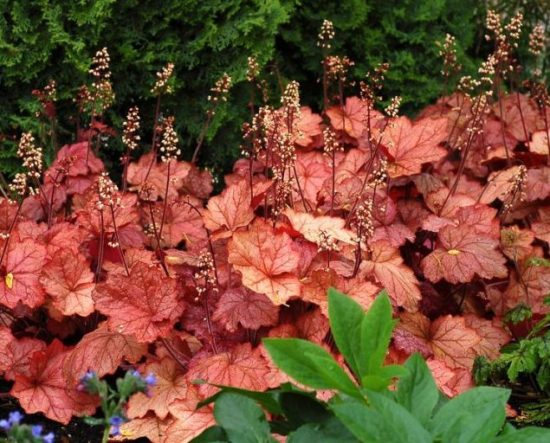
Georgia Peach |
This variety of heuchera prefers to grow in partial shade or shade, but can also feel excellent in an open sunny area. It is not afraid of prolonged heat, prolonged drought and excessive soil moisture.The flowering period begins in the early summer season.
|
Heuchera Georgia Peach |
The crop attracts attention with its spectacular leaf blades, which change color during the summer months - first from orange to red, then from red to pink, and from pink to purple. An important care item is the regular removal of wilted inflorescences.
- Bush height – 30-90 cm
- Bush width – 30-60 cm
- Distance between plants – 45-60 cm
- Flowering time: end of May – beginning of July
- Lighting – sun, partial shade, shade
Paris
|
Heuchera decorative-blooming Paris (Paris) |
It is distinguished by its ability to withstand drought, winter frosts, pests and diseases. Timely watering is required on very hot days and additional shelter during sudden drops in temperature.
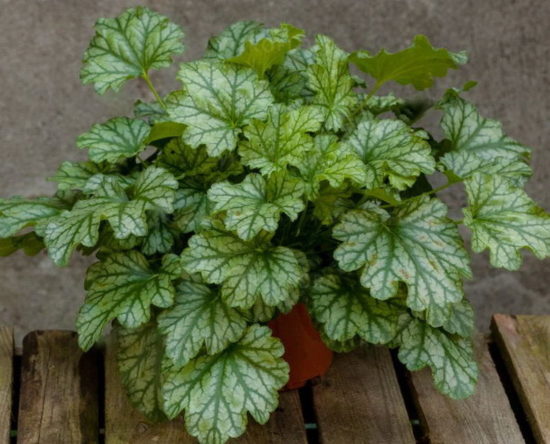
The variety attracts attention with bright pink inflorescences and soft green leaves with darker veins. |
- Bush height – 17-30 cm
- Bush width – 30-60 cm
- Distance between plants – 30-40 cm
- Flowering time: end of May – end of August
- Lighting – partial shade, shadow
Forever Purple
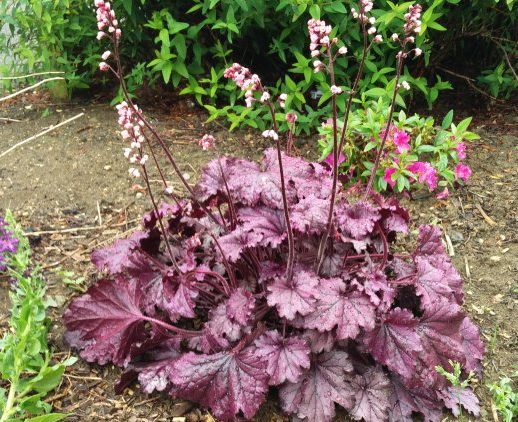
Photo of Heuchera Forever Purple |
A variety with high resistance to drought and cold winters, it has no special requirements regarding lighting. It is distinguished by soft pink inflorescences and luxurious leaf plates that change their purple color to violet-eggplant.
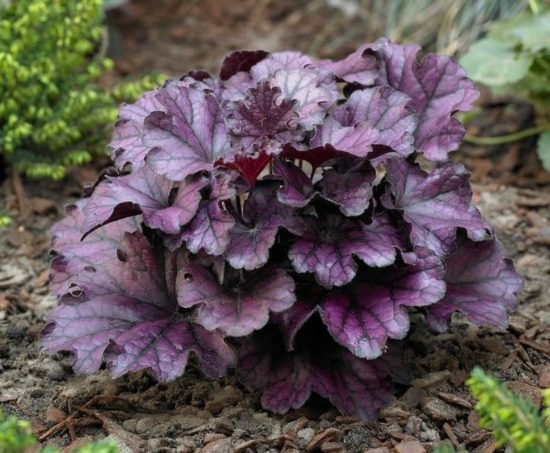
Forever Purple |
- Bush height – 25-30 cm
- Bush width – 50-55 cm
- Distance between plants – 50-60 cm
- Flowering time: end of May - July
- Lighting – sun, partial shade, shade
Green Spice
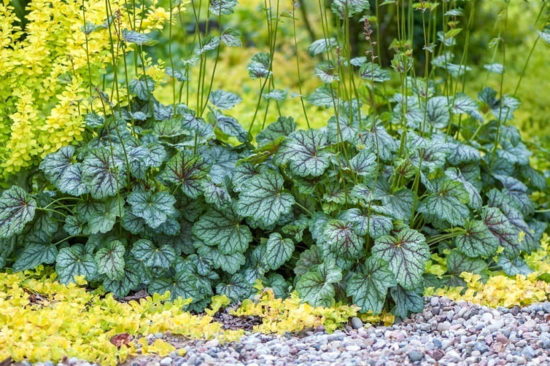
Green Spice |
The most popular variety among flower growers and landscape designers is of American origin. Plants exhibit their best decorative qualities in shady areas with moderate soil moisture. The leaves change their color gradually.
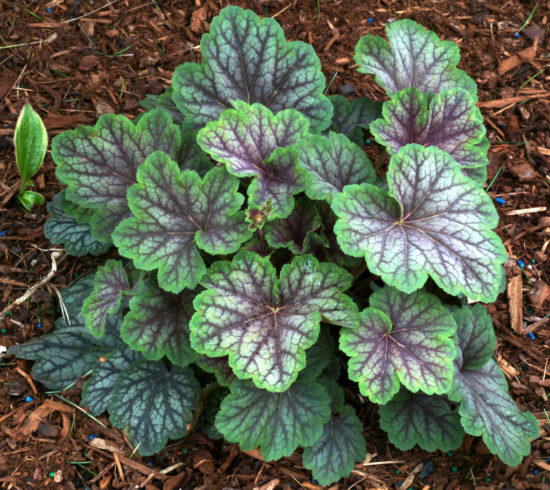
Green Spice |
At first they attract the eye with their rich green, light silvery tint, veins with greenish and purple colors and a soft green edging along the edge of the leaf blade. After some time, the foliage becomes yellowish-red.
- Bush height – 22-90 cm
- Bush width – 30-60 cm
- Distance between plants – 30-45 cm
- Flowering time: end of May – beginning of July
- Lighting – partial shade, shadow
Electra

Electra A distinctive feature of the variety is the leaf blades, which at the beginning of summer are colored in yellow and green shades (with dark orange veins), and by the end of August they become peach-colored. |
An easy-to-care hybrid of American origin that does not require shelter during the winter season. The bushes require regular watering in spring and summer, as well as shading from direct and bright sunlight.
- Bush height – 20-30 cm
- Bush width – 30-60 cm
- Distance between plants – 30-37 cm
- Flowering time: end of May - June
- Lighting – partial shade, shadow
Midnight Rose
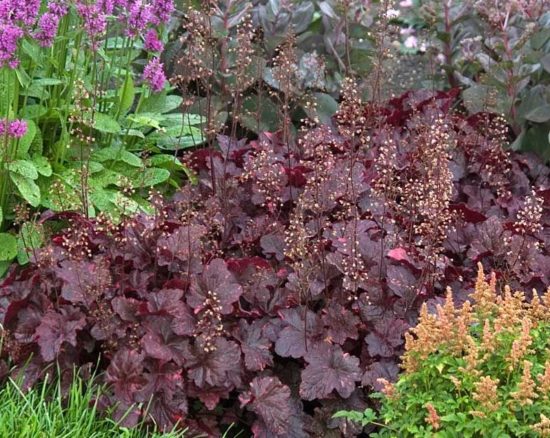
Midnight Rose |
“Midnight Rose” (translated from English) negatively relates to poor soil and insufficient lighting.
|
It stands out among other varieties with bright pink flowers and burgundy (and sometimes almost black) leaves. |
- Bush height – 25-60 cm
- Bush width – 30-60 cm
- Distance between plants – 30-45 cm
- Flowering time: end of May - July
- Lighting – sun, partial shade
Marmalade
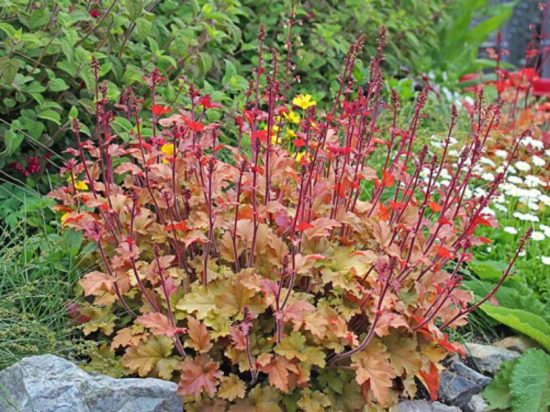
Marmalade |
A versatile variety in terms of growing area, it can be planted in flower beds and containers, but always with good sunlight during the day (or light shading). A site in the southwestern side of the garden will be most favorable for the plant.
|
A special feature of this variety is its pinkish-burgundy leaves, which are atypical in shape and resemble bells. |
- Bush height – 30-90 cm
- Bush width – 30-60 cm
- Distance between plants – 45-60 cm
- Flowering time: end of May – beginning of July
- Lighting – sun, partial shade
Glitter
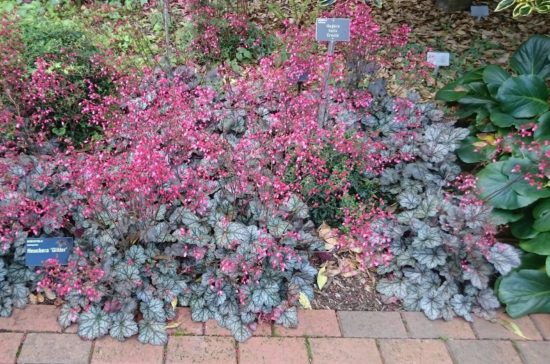
Glitter |
A hybrid variety that prefers to grow in the shade of tall representatives of the flora. Plants are advised to be planted in the circles of tall neighbors, since hybrids have a negative attitude towards bright sunlight. In the garden, you need to choose areas in the north-east direction.
|
The pride of this variety is its unusually colored leaves - silver-purple on the outside and bright purple on the inside. |
- Bush height – 20-25 cm
- Bush width – 30-35 cm
- Distance between plants – 30-40 cm
- Flowering time: end of May - June
- Lighting – partial shade, shadow
Ginger Ale
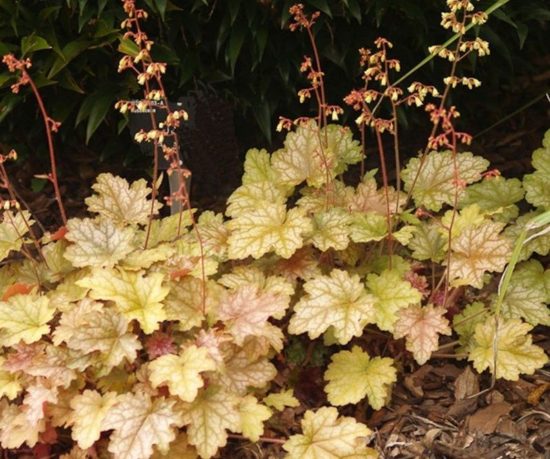
Ginger Ale |
The variety is resistant to humid and hot summer periods and is not afraid of drought and prolonged rains. Prefers to grow in moist, nutritious soil with partial shade. Has a negative attitude towards bright sunlight.
|
The highlight of this variety is the amber-colored leaves with coral veins and a slight sheen of silver. |
- Bush height – 20-30 cm
- Bush width – 25-30 cm
- Distance between plants – 22-30 cm
- Flowering time: end of May - June
- Lighting – partial shade, shadow
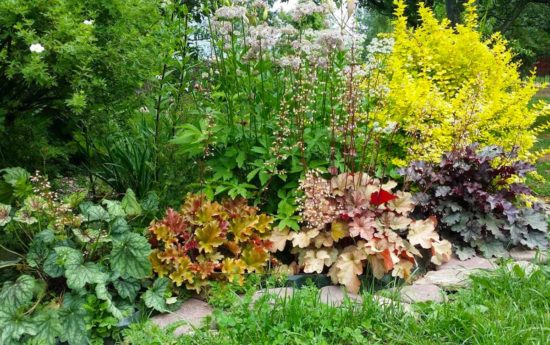
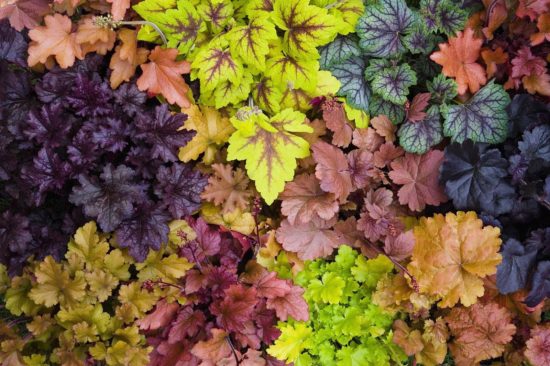
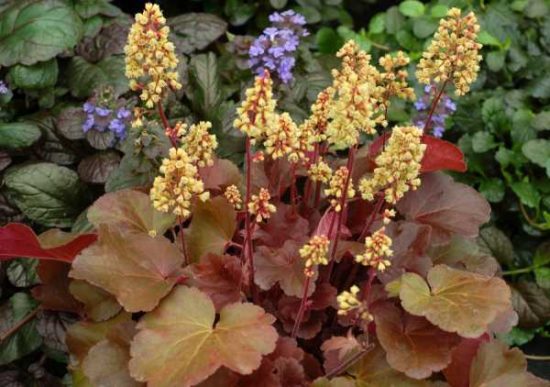
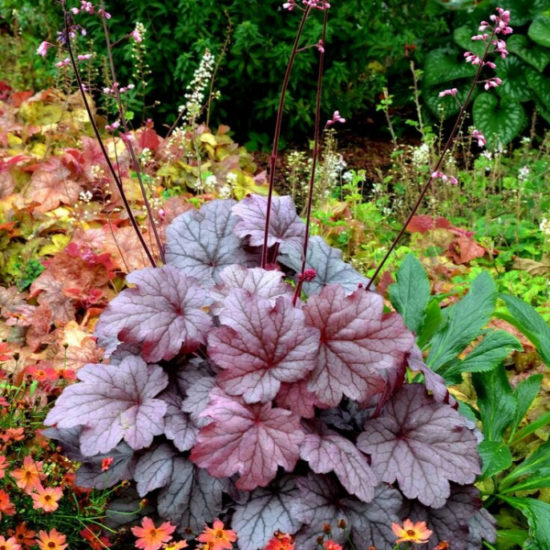
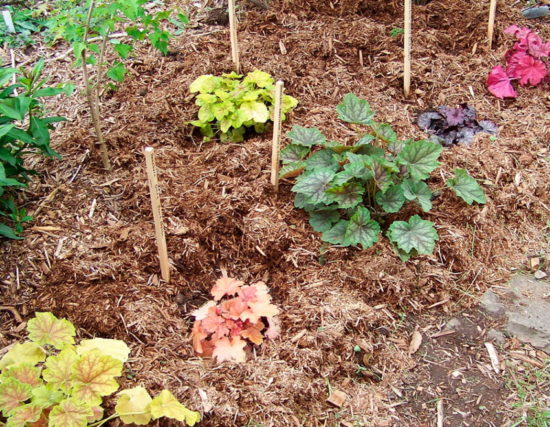
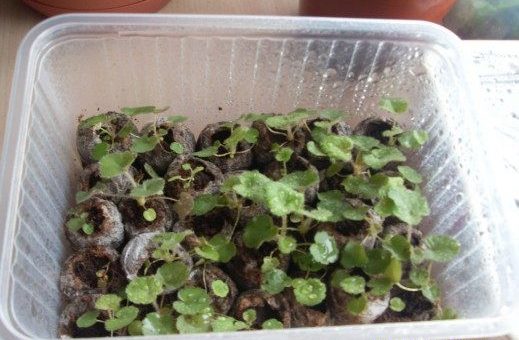
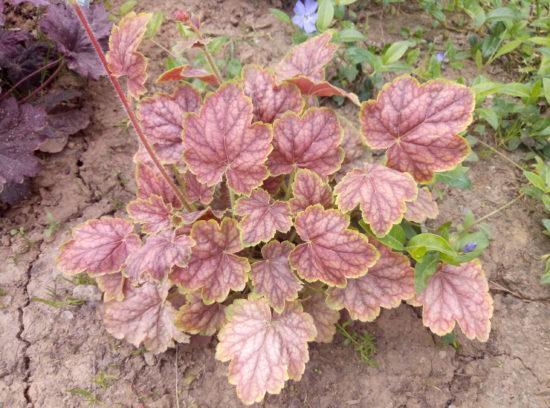
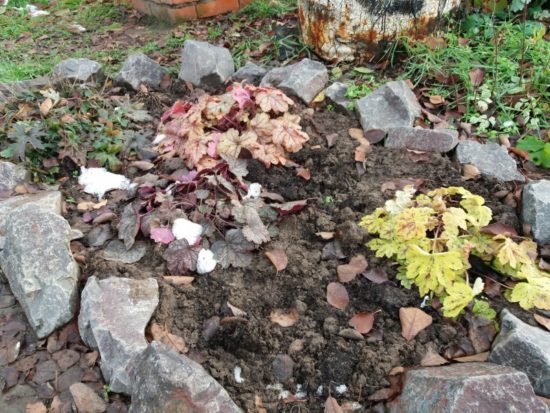
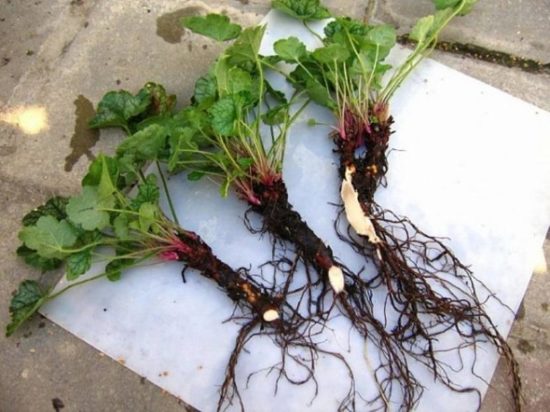
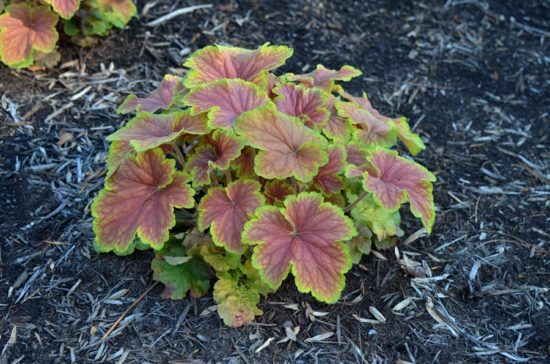
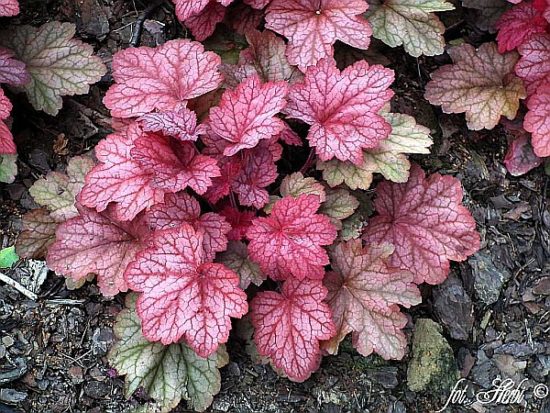
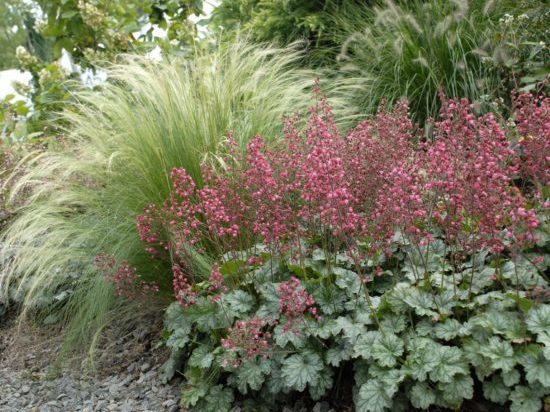
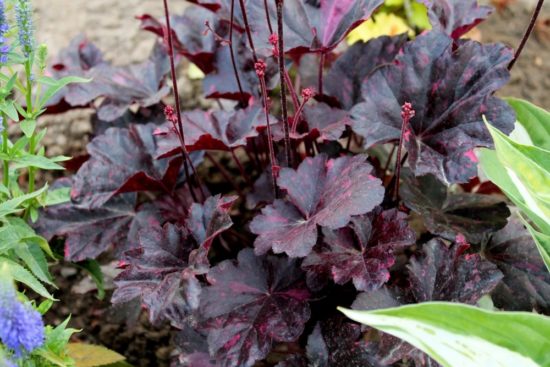

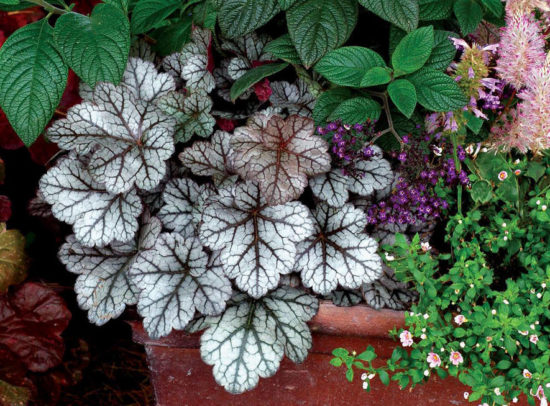
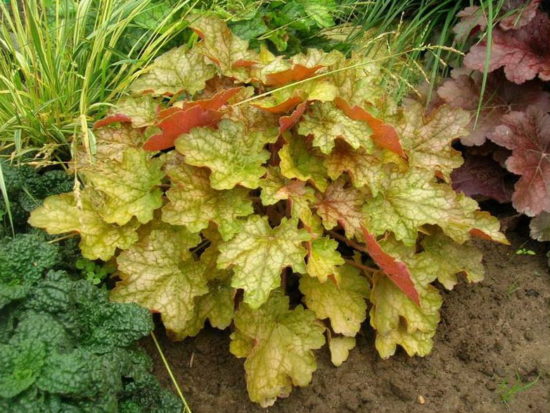

 CUCUMBERS NEVER GET SICK, I'VE BEEN USING ONLY THIS FOR 40 YEARS! I SHARE A SECRET WITH YOU, CUCUMBERS ARE LIKE THE PICTURE!
CUCUMBERS NEVER GET SICK, I'VE BEEN USING ONLY THIS FOR 40 YEARS! I SHARE A SECRET WITH YOU, CUCUMBERS ARE LIKE THE PICTURE! You can dig a bucket of potatoes from each bush. Do you think these are fairy tales? Watch the video
You can dig a bucket of potatoes from each bush. Do you think these are fairy tales? Watch the video
 How our fellow gardeners work in Korea. There is a lot to learn and just fun to watch.
How our fellow gardeners work in Korea. There is a lot to learn and just fun to watch. Eye trainer. The author claims that with daily viewing, vision is restored. They don't charge money for views.
Eye trainer. The author claims that with daily viewing, vision is restored. They don't charge money for views. A 3-ingredient cake recipe in 30 minutes is better than Napoleon. Simple and very tasty.
A 3-ingredient cake recipe in 30 minutes is better than Napoleon. Simple and very tasty. Therapeutic exercises for cervical osteochondrosis. A complete set of exercises.
Therapeutic exercises for cervical osteochondrosis. A complete set of exercises. Which indoor plants match your zodiac sign?
Which indoor plants match your zodiac sign? What about them? Excursion to German dachas.
What about them? Excursion to German dachas.